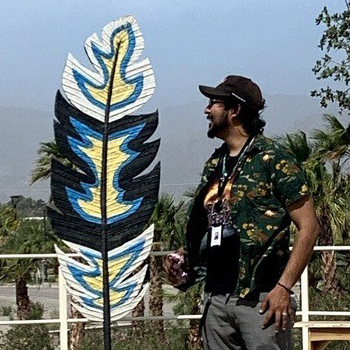
Nic Rajen
- BS Physics (2015)
- Tribal Educator and Developer Specialist
Current Work Location:
Intertribal Agriculture Council
nic@indianag.org / 951-933-7980
Bio
Q: How did you choose your career, and what steps did you take to embark on this career path after your physics degree?
A: My pursuit of a B.S in Physics was sparked by a curiosity of the universe, and allowed me to cultivate a first principles skillset I determined to focus towards sustainable energy systems and environmental regeneration (being a member of the Navajo Nation, the scars of environmental destruction due to numerous causes including, but not limited to, the relatively toxic mining spill from the EPA, and the history of uranium mining, have affected my family and community). To assist me in researching and developing such systems, I went on to obtain a graduate degree from UC Riverside's Materials Science and Engineering program (a choice inspired by a senior peer mentor from UNM). At UCR, I researched in computational condensed matter physics, but also became involved with the school's Native American Student Programs - re-founding the UCR chapter of the American Indian Science and Engineering Society - and chanced upon an opportunity to become a teacher at the newly forming California Indian Nation's College. After receiving my masters in MSE, I became a teacher of math, science and adult education at the California Indian Nations College, in addition to environmental stewardship, advocacy and education programs work at the Native American Land Conservancy.
I later moved to Salinas, California with my wife, and started work with the Amah Mutsun Land Trust. There I directed forest, ocean and prescribed burning environmental stewardship. I have organized research and education programs that promote indigenous perspectives in resource management that had been frequently and systematically performed by Indigenous people for millennia, to help prevent further environmental destruction by wildfires such as the CZU lightning complex fires which burned millions of acres of land. Driven by a desire to regenerate the earth, and an innate understanding that Indigenous knowledge of the sciences is far more extensive than society gives credit for, I have simultaneously directed education efforts towards inspiring Indigenous youth and communities to rekindle and use Indigenous STEM+Medicine Art and Psychology concepts, as well as traditional ecological knowledge and technology. I have also worked to educate the general public and global communities on the same topics, so that we all may find empirical, novel solutions to the many challenges and questions that face the planet today and tomorrow.
Q: How has your physics degree shaped and helped your career?
A: My degree in physics, including the classroom work combined with undergraduate research opportunities provided through the McNair Program, UNM Physics and Astronomy department, and NASA NM Space Program, has been the bedrock for my varied and rewarding career. Graduate engineering programs, especially research laboratories, love a student with a physics degree! I am able to research and communicate advanced scientific concepts in a plethora of fields to students and audiences from almost any background, only limited by language. And my study allows me to advocate for incredible and rigorous technological efforts conducted by Indigenous peoples. One example is the LIDAR supported research of the Yucatan region that aided in identifying zeolite and quartz quarries utilized by Mayan engineers to mine for water purification materials that were then transported to their villages and cities to inlay and augment water systems, resulting in the cleanest and purest water on Earth! I also greatly benefitted from the UNM Society of Physics Students Chapter and student body.
Q: What do you like most about your current job?
A: I love being able to learn, educate, and conduct research, at every level of my career. Now, working on an organic, Tribally run farm and reservation, I love learning about the chemistry and science of plant health, the microcosmos of the soil and how the health of the environment and soil directly correlates to the health and internal environment of our internal microbiome; the way the microbes in the environmental sky islands of mountains mix with the microbiota of clouds and the atmosphere, connecting the earth's poles and highest mountains to the hottest deserts and deepest oceans. I love learning about the physics of fire and landscape phenomena and climatic processes - regimes that can be healthy if practiced intentionally. For example, controlled fires can be beneficial if burned softly and frequently, and release bioavailable nutrients. I work to discourage and prevent fire regimes that can sterilize soil or exacerbate climate change through superheated burning when natural fire takes flight (whether by lightning, arson, or a baby gender reveal) in environments that have built up organic matter over decades of fire suppression policies. And I get to take this knowledge of physics and newly learned knowledge of mycorrhizal root systems and atmospheric science to develop lessons, activities and demonstrations for youth and the general public to deepen societies appreciation for science! I also love being able to discuss these topics and continue to learn from my brother Ivan, a fellow UNM PandA alumni.
Q: Can interested students contact you for more information on your career path?
A: Yes! By email at: nrconrad93 at gmail dot com
